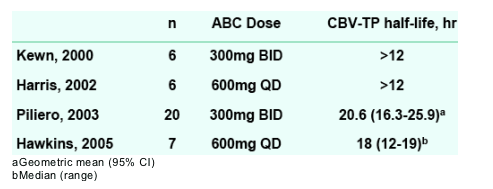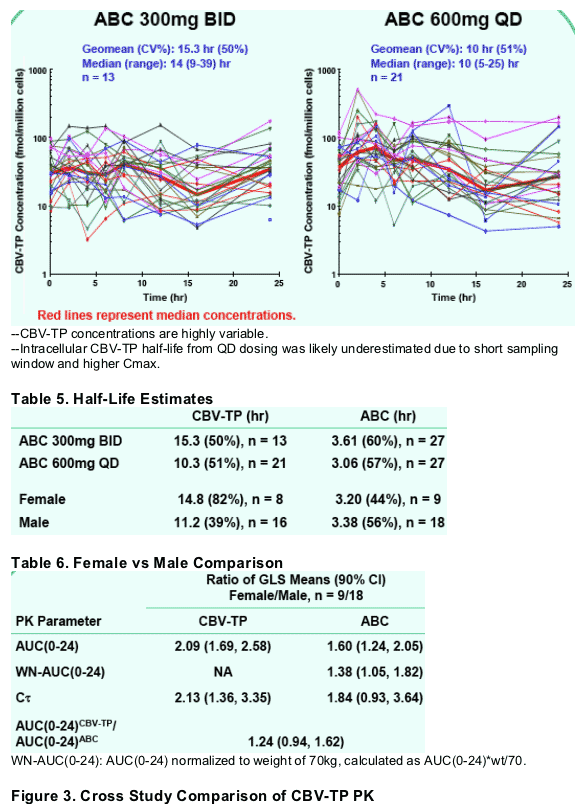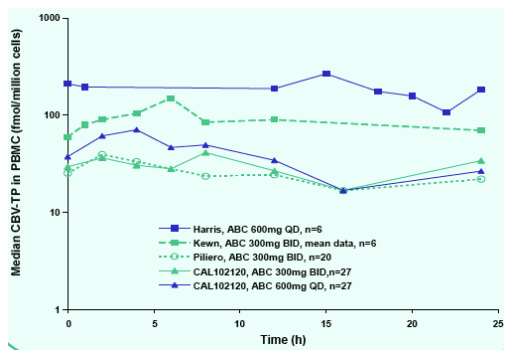 |
 |
 |
| |
An Open-Label, Two-Period, Crossover, PK Study of Abacavir (ABC) and Its Intracellular Anabolite Carbovir Triphosphate (CBV-TP) Following
600mg Once-Daily and 300mg Twice-Daily Administration of Abacavir in HIV-Infected Subjects
|
| |
| |
Reported by Jules Levin
4th IAS Conference, 22-25 July, 2007, Sydney, Australia
G Moyle1, C Fletcher1, C Higgs1, I Song2, Y Lou2, J Lin2, G Yuen2, E Guerini2, P Hay3, Marta Boffito1
1St. Stephen's Centre, Chelsea and Westminster Hospital, London, UK;
2GlaxoSmithKline, CPDM/CPSP, RTP, USA;
3Genito-Urinary Medicine, St. George's Hospital, London, UK
AUTHOR CONCLUSIONS
Intracellular CBV-TP exposure from ABC 600mg QD exceeds that from ABC 300mg BID while plasma ABC exposure was similar, supporting ABC QD dosing.
Intracellular CBV-TP and plasma ABC exposures were higher in females than males.
No cases of ABC HSR and new safety issues with the switch in ABC dosing frequency.
BACKGROUND
--Ziagen (ABC) is approved for 300mg BID or 600mg QD1,2.
--ABC has a short half-life in plasma (about 1.5hr).
--Intracellular CBV-TP is the active moiety of ABC with prolonged intracellular half-life.
--Previous studies on intracellular CBV-TP in HIV patients.

OBJECTIVES
Primary: To compare CBV-TP PK following ABC 300mg BID and 600mg QD in HIV-infected patients.
Secondary:To compare plasma ABC PK following ABC 300mg BID and 600mg QD.
-- assess gender difference in plasma ABC and intracellular CBV-TP PK.
-- To assess safety and tolerability of ABC 300mg and 600mg QD dosing.
DESIGN
Open label, non-randomized, two-period, crossover.

Population: 30 HIV-infected male/female currently on PK Parameter ABC-containing regimen for at least 8 weeks, VL < 400 copies/mL and CD4 > 250 cells/mm3 at screening.
PK assessment: 24-h serial PK sampling of plasma and PBMC on Days 1 and 11 (evening dose skipped during BID dosing period).
Safety assessment: adverse events (AEs), clinical lab, and vital signs
METHODS
--Plasma and PBMC samples were analyzed by validated LC/MS/MS assays.
PK parameters obtained by non-compartmental analysis: AUC(0-_), AUC(0-24),
---Cavg, Cmax, C_, and half-life.
--Statistics: treatment comparison and gender effect by ANOVA with mixed effect model.

Demographics
Male/Female: n(%) 23 (70%)/10 (30%)
Age in year: median (range) 44 (25-66)
Weight in kg: median (range) 69 (51-97)
1. Subjects withdrew due to positive drug test (2), intoxicated at check-in on Day 10 (1), and abnormal lab (2).
2. Two subjects were excluded from statistical analysis due to missing dosing records within 3 days prior to blood sampling.



SAFETY
--Few subjects (12%) reported AEs with either ABC 300mg BID or 600mg QD.
--Most frequent drug-related AEs diarrhea and nausea.
--No deaths, SAEs or withdrawals due to AEs reported.
--No vital sign or laboratory trends in either treatment group.
--No cases of hypersensitivity reaction (HSR) noted with the switch in ABC dosing.
|
| |
|
 |
 |
|
|